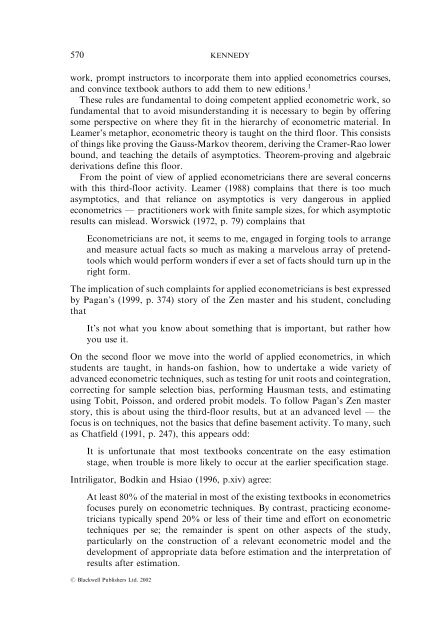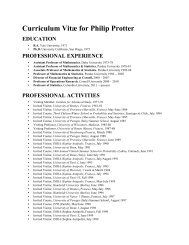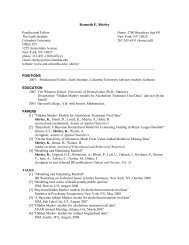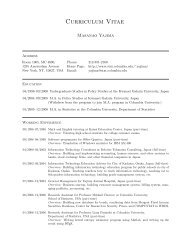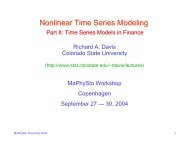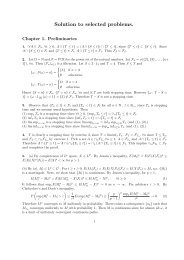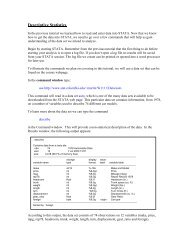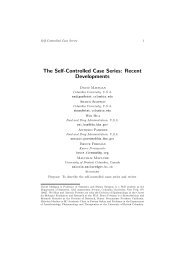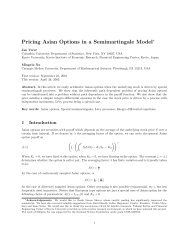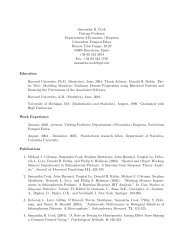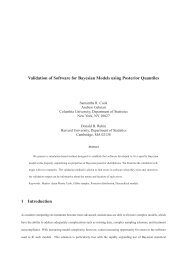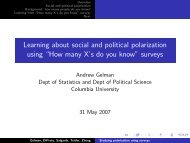sinning in the basement: what are the rules? the ten commandments ...
sinning in the basement: what are the rules? the ten commandments ...
sinning in the basement: what are the rules? the ten commandments ...
Create successful ePaper yourself
Turn your PDF publications into a flip-book with our unique Google optimized e-Paper software.
570 KENNEDY<br />
work, prompt <strong>in</strong>structors to <strong>in</strong>corporate <strong>the</strong>m <strong>in</strong>to applied econometrics courses,<br />
and conv<strong>in</strong>ce textbook authors to add <strong>the</strong>m to new editions. 1<br />
These <strong>rules</strong> <strong>are</strong> fundamental to do<strong>in</strong>g compe<strong>ten</strong>t applied econometric work, so<br />
fundamental that to avoid misunderstand<strong>in</strong>g it is necessary to beg<strong>in</strong> by offer<strong>in</strong>g<br />
some perspective on where <strong>the</strong>y fit <strong>in</strong> <strong>the</strong> hierarchy of econometric material. In<br />
Leamer’s metaphor, econometric <strong>the</strong>ory is taught on <strong>the</strong> third floor. This consists<br />
of th<strong>in</strong>gs like prov<strong>in</strong>g <strong>the</strong> Gauss-Markov <strong>the</strong>orem, deriv<strong>in</strong>g <strong>the</strong> Cramer-Rao lower<br />
bound, and teach<strong>in</strong>g <strong>the</strong> details of asymptotics. Theorem-prov<strong>in</strong>g and algebraic<br />
derivations def<strong>in</strong>e this floor.<br />
From <strong>the</strong> po<strong>in</strong>t of view of applied econometricians <strong>the</strong>re <strong>are</strong> several concerns<br />
with this third-floor activity. Leamer (1988) compla<strong>in</strong>s that <strong>the</strong>re is too much<br />
asymptotics, and that reliance on asymptotics is very dangerous <strong>in</strong> applied<br />
econometrics — practitioners work with f<strong>in</strong>ite sample sizes, for which asymptotic<br />
results can mislead. Worswick (1972, p. 79) compla<strong>in</strong>s that<br />
Econometricians <strong>are</strong> not, it seems to me, engaged <strong>in</strong> forg<strong>in</strong>g tools to arrange<br />
and measure actual facts so much as mak<strong>in</strong>g a marvelous array of pre<strong>ten</strong>dtools<br />
which would perform wonders if ever a set of facts should turn up <strong>in</strong> <strong>the</strong><br />
right form.<br />
The implication of such compla<strong>in</strong>ts for applied econometricians is best expressed<br />
by Pagan’s (1999, p. 374) story of <strong>the</strong> Zen master and his student, conclud<strong>in</strong>g<br />
that<br />
It’s not <strong>what</strong> you know about someth<strong>in</strong>g that is important, but ra<strong>the</strong>r how<br />
you use it.<br />
On <strong>the</strong> second floor we move <strong>in</strong>to <strong>the</strong> world of applied econometrics, <strong>in</strong> which<br />
students <strong>are</strong> taught, <strong>in</strong> hands-on fashion, how to undertake a wide variety of<br />
advanced econometric techniques, such as test<strong>in</strong>g for unit roots and co<strong>in</strong>tegration,<br />
correct<strong>in</strong>g for sample selection bias, perform<strong>in</strong>g Hausman tests, and estimat<strong>in</strong>g<br />
us<strong>in</strong>g Tobit, Poisson, and ordered probit models. To follow Pagan’s Zen master<br />
story, this is about us<strong>in</strong>g <strong>the</strong> third-floor results, but at an advanced level — <strong>the</strong><br />
focus is on techniques, not <strong>the</strong> basics that def<strong>in</strong>e <strong>basement</strong> activity. To many, such<br />
as Chatfield (1991, p. 247), this appears odd:<br />
It is unfortunate that most textbooks concentrate on <strong>the</strong> easy estimation<br />
stage, when trouble is more likely to occur at <strong>the</strong> earlier specification stage.<br />
Intriligator, Bodk<strong>in</strong> and Hsiao (1996, p.xiv) agree:<br />
At least 80% of <strong>the</strong> material <strong>in</strong> most of <strong>the</strong> exist<strong>in</strong>g textbooks <strong>in</strong> econometrics<br />
focuses purely on econometric techniques. By contrast, practic<strong>in</strong>g econometricians<br />
typically spend 20% or less of <strong>the</strong>ir time and effort on econometric<br />
techniques per se; <strong>the</strong> rema<strong>in</strong>der is spent on o<strong>the</strong>r aspects of <strong>the</strong> study,<br />
particularly on <strong>the</strong> construction of a relevant econometric model and <strong>the</strong><br />
development of appropriate data before estimation and <strong>the</strong> <strong>in</strong>terpretation of<br />
results after estimation.<br />
# Blackwell Publishers Ltd. 2002


